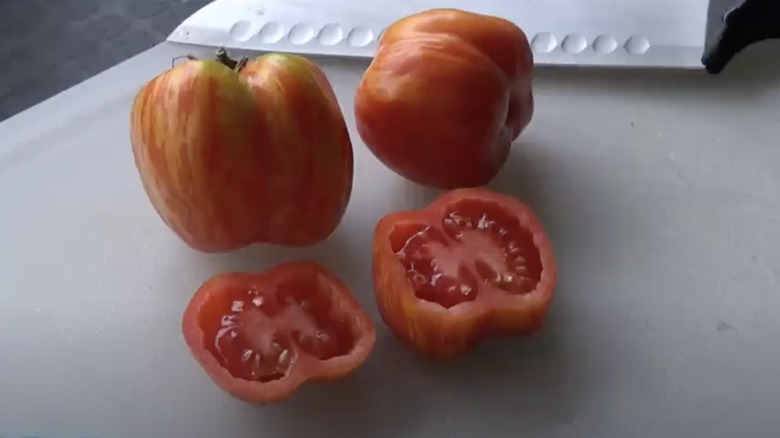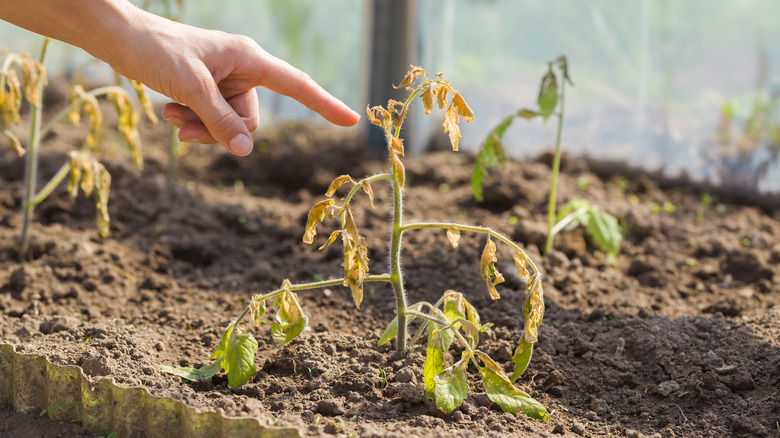Here's Why Your Tomato Plants Are Hollow Inside
Juicy and flavorful homegrown tomatoes are a great addition to both your kitchen and garden. However, while tomatoes are often cited as a relatively easy-to-grow plant, they can suffer from a few common ailments from yellow leaves to cracked skin and fungal infections. While you may have successfully solved a few of these tomato problems before, one problem you may not have expected to face is cutting into a perfect-looking tomato only to find that it's hollow on the inside. Hollow — or puffy — tomatoes occur when there are empty spaces between the seed clusters and the outer fruit of the tomato. This means that your hollow tomato will be less juicy and all around not as good when compared to a normal healthy tomato.
There are a few reasons why this can occur and, usually, it is due to weather conditions or lack of adequate pollination. However, before you start troubleshooting your tomatoes, it's a good idea first to make sure you haven't accidentally planted stuffing tomatoes. Stuffing tomatoes are a variety of tomatoes that are purposely meant to be hollow so they can be stuffed and baked like bell peppers. However, if you know you haven't purchased stuffing tomatoes, then here are a few possible causes behind the hollow tomato problem and some solutions you can start implementing.
Causes and fixes for hollow puffy tomatoes
If your tomatoes are mostly full and juicy with only a few hollow sections inside, then there is likely nothing you need to do because this problem will fix itself as the growing season continues. Tomatoes that are hollow in only a few sections are natural during an early harvest in years when high temperatures or too much rain prevent normal pollination. This problem should improve as the weather gets better and the harvest continues.
However, if you cut open your tomatoes and they are hollow in all modules, or if this problem continues through the growing season, this is a sign of a more serious issue. Many times, the cause of fully hollow tomatoes is either inadequate pollination or excess nitrogen in the soil. If inadequate pollination is the problem, you can try manually pollinating the plants by shaking them or brushing the flowers with a paintbrush or toothbrush to spread the pollen around.
Excess nitrogen in the soil often happens when too much nitrogen-based fertilizer is added in spring during years with lots of rain. Unfortunately, if this is the cause of your hollow tomatoes, there's nothing you can do to fix the problem for the current harvest. For the following year, make sure to test the soil before adding fertilizer and avoid using ultra-concentrated forms of nitrogen fertilizers like Urea.
What if the stems of the plant are hollow?
If the stems and branches of your tomato plant are hollow then that's a different story. In some cases, if you find hollow stems with entrance holes somewhere near the bottom of the plant, then this was likely caused by burrowing worms or caterpillars who got into your plants and ate out the center. This type of damage usually occurs in late June or early August, and you may even still find the critter inside your tomato plant. However, if stalk-borrowing pests weren't the cause, you may have a more serious problem on your hands.
Many different types of plant bacterial infections from stem rot to pith necrosis cause hollow tomato stems. These types of bacterial infections tend to have similar symptoms including brown spots on the plant, hollow stems, and yellowing leaves. Oftentimes, by the time this problem is detected, the tomato plants with these infections are too far gone to save and the best course of action is to pull the plant — roots and all — to prevent it from infecting others. You will also need to sanitize your tools and wash your hands after pulling to prevent the spread of the bacteria.


